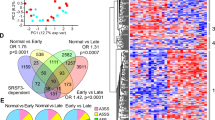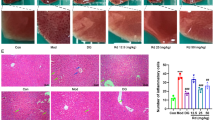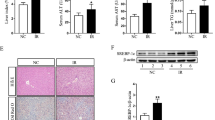Abstract
Rad50-interacting protein (RINT1) interacts with the endoplasmic reticulum (ER) tethering and SNARE complex, playing a central role in membrane trafficking and lipid metabolism. Loss-of-function variants of RINT1 have been related to episodic severe transaminitis with skeletal dysplasia or spastic paraplegia. We report two unrelated patients with recurrent markedly elevated aminotransferase triggered by fever, accompanied by coagulopathy and hyperammonemia. Liver biopsy revealed liver steatosis and bridging fibrosis in one patient, while the other displayed mild hepatocyte enlargement. Trio-whole-exome sequencing identified biallelic pathogenic RINT1 variants in the two patients. A novel missense variant [c.662 A > C, p.(His221Pro)] and a recurrent splice-site variant (c.1333+1 G > A) were identified in the first case. In the second case, a recurrent pathogenic RINT1 homozygous missense variant [c.1102 G > A, p.(Ala368Thr)] was identified. We investigated the pathogenicity of these variants through immunoprecipitation. Recombinant proteins produced from the mutant RINT1 transcript (p.His221Pro or p.Ala368Thr) displayed disrupted ER tether and SNARE interactions. Since the inhibition of ER-Golgi transport is associated with ER-stress activation, unfolded protein response (UPR)-related gene expression was investigated by qPCR. TIP20, a RINT1 homolog in Saccharomyces cerevisiae, is needed for autophagosome formation; therefore, an LC3-II turnover assay was performed and revealed disrupted autophagic flux. In addition, we created a fat-body-specific Rint1 knockdown in Drosophila. In the mutant larva, tissue atrophy and decreased lipid droplets in the fat body were observed. These results indicated that a loss of RINT1 function activated the UPR, impairs autophagy, and led to lipid storage abnormalities, contributing to the pathogenesis of liver disease.
This is a preview of subscription content, access via your institution
Access options
Subscribe to this journal
Receive 12 print issues and online access
$259.00 per year
only $21.58 per issue
Buy this article
- Purchase on SpringerLink
- Instant access to full article PDF
Prices may be subject to local taxes which are calculated during checkout





Similar content being viewed by others
References
Arasaki K, Taniguchi M, Tani K, Tagaya M. RINT-1 regulates the localization and entry of ZW10 to the syntaxin 18 complex. Mol Biol Cell. 2006;17:2780–8.
He S, Ni D, Ma B, Lee JH, Zhang T, Ghozalli I, et al. PtdIns(3)P-bound UVRAG coordinates Golgi–ER retrograde and Atg9 transport by differential interactions with the ER tether and the Beclin 1 complex. Nat Cell Biol. 2013;15:1206–19.
Xu D, Li Y, Wu L, Li Y, Zhao D, Yu J, et al. Rab18 promotes lipid droplet growth by tethering the ER to LDs through SNARE and NRZ interactions. J Cell Biol. 2018;217:975–95.
Davis S, Wang J, Ferro-Novick S. Crosstalk between the secretory and autophagy pathways regulates autophagosome formation. Dev Cell. 2017;41:23–32.
Chen L, Zhang C, Liang Y, Liu A, Dong H, Zou S. Autophagy requires Tip20 in Saccharomyces cerevisiae. J Biosci. 2019;44:17.
Cousin MA, Conboy E, Wang JS, Lenz D, Schwab TL, Williams M, et al. RINT1 biallelic variations cause infantile-onset recurrent acute liver failure and skeletal abnormalities. Am J Hum Genet. 2019;105:108–21.
Launay N, Ruiz M, Planas-Serra L, Verdura E, Rodríguez-Palmero A, Schlüter A, et al. RINT1 deficiency disrupts lipid metabolism and underlies a complex hereditary spastic paraplegia. J Clin Invest. 2023;133:e162836.
Quiroz V, Planas-Serra L, Sveden A, Tam A, Kim HM, Zubair U, et al. Biallelic variants in RINT1 present as early-onset pure hereditary spastic paraplegia. J Clin Invest. 2024;134:e178919.
Takeuchi I, Yanagi K, Takada S, Uchiyama T, Igarashi A, Motomura K, et al. STAT6 gain-of-function variant exacerbates multiple allergic symptoms. J Allergy Clin Immunol. 2023;151:1402–6.e6.
Jumper J, Evans R, Pritzel A, Green T, Figurnov M, Ronneberger O, et al. Highly accurate protein structure prediction with AlphaFold. Nature. 2021;596:583–9.
Schnorrer F, Schönbauer C, Langer CC, Dietzl G, Novatchkova M, Schernhuber K, et al. Systematic genetic analysis of muscle morphogenesis and function in Drosophila. Nature. 2010;464:287–91.
Araki M, Kurihara M, Kinoshita S, Awane R, Sato T, Ohkawa Y, et al. Anti-tumour effects of antimicrobial peptides, components of the innate immune system, against hematopoietic tumors in Drosophila mxc mutants. Dis Model Mech. 2019;12:dmm037721.
Oka S, Hirai J, Yasukawa T, Nakahara Y, Inoue YH. A correlation of reactive oxygen species accumulation by depletion of superoxide dismutases with age-dependent impairment in the nervous system and muscles of Drosophila adults. Biogerontology. 2015;16:485–501.
Kitazawa D, Yamaguchi M, Mori H, Inoue YH. COPI-mediated membrane trafficking is required for cytokinesis in Drosophila male meiotic divisions. J Cell Sci. 2012;125:3649–60.
Barlow DJ, Thornton JM. Helix geometry in proteins. J Mol Biol. 1988;201:601–19.
Eisenberg D, Schwarz E, Komaromy M, Wall R. Analysis of membrane and surface protein sequences with the hydrophobic moment plot. J Mol Biol. 1984;179:125–42.
Tanford C. Contribution of hydrophobic interactions to the stability of the globular conformation of proteins. J Am Chem Soc. 1962;84:4240–7.
Pace CN, Fu H, Fryar KL, Landua J, Trevino SR, Shirley BA, et al. Contribution of hydrophobic interactions to protein stability. J Mol Biol. 2011;408:514–28.
Peters B, Dattner T, Schlieben LD, Sun T, Staufner C, Lenz D. Disorders of vesicular trafficking presenting with recurrent acute liver failure: NBAS, RINT1, and SCYL1 deficiency. J Inherit Metab Dis. 2025;48:e12707.
Mann JP, Lenz D, Stamataki Z, Kelly D. Common mechanisms in pediatric acute liver failure. Trends Mol Med. 2023;29:228–40.
Grigaravicius P, Kaminska E, Hübner CA, McKinnon PJ, von Deimling A, Frappart PO. Rint1 inactivation triggers genomic instability, ER stress and autophagy inhibition in the brain. Cell Death Differ. 2016;23:454–68.
Kabeya Y, Mizushima N, Ueno T, Yamamoto A, Kirisako T, Noda T, et al. LC3, a mammalian homologue of yeast Apg8p, is localized in autophagosome membranes after processing. EMBO J. 2000;19:5720–8.
Mizushima N, Yoshimori T, Levine B. Methods in mammalian autophagy research. Cell. 2010;140:313–26.
Lin X, Liu CC, Gao Q, Zhang X, Wu G, Lee WH. RINT-1 serves as a tumor suppressor and maintains Golgi dynamics and centrosome integrity for cell survival. Mol Cell Biol. 2007;27:4905–16.
Dombroski BA, Nayak RR, Ewens KG, Ankener W, Cheung VG, Spielman RS. Gene expression and genetic variation in response to endoplasmic reticulum stress in human cells. Am J Hum Genet. 2010;86:719–29.
Saitsu H, Nishimura T, Muramatsu K, Kodera H, Kumada S, Sugai K, et al. De novo mutations in the autophagy gene WDR45 cause static encephalopathy of childhood with neurodegeneration in adulthood. Nat Genet. 2013;45:445–9. 449.e1.
Kim M, Sandford E, Gatica D, Qiu Y, Liu X, Zheng Y, et al. Mutation in ATG5 reduces autophagy and leads to ataxia with developmental delay. Elife. 2016;5:e12245.
Ji J, Yang M, Jia J, Wu Q, Cong R, Cui H, et al. A novel variant in NBAS identified from an infant with fever-triggered recurrent acute liver failure disrupts gene function. Hum Genome Var. 2023;10:13.
Rao J, Zhang C, Wang P, Lu L, Qian X, Qin J, et al. C/EBP homologous protein (CHOP) contributes to hepatocyte death via promotion of ERO1α signalling in acute liver failure. Biochem J. 2015;466:369–78.
Yeh KY, Lai CY, Lin CY, Hsu CC, Lo CP, Her GM. ATF4 overexpression induces early-onset hyperlipidemia, hepatic steatosis and enhanced adipogenesis in zebrafish. Sci Rep. 2017;7:16362.
Yorimitsu T, Nair U, Yang Z, Klionsky DJ. Endoplasmic reticulum stress triggers autophagy. J Biol Chem. 2006;281:30299–304.
González-Rodríguez Á, Mayoral R, Agra N, et al. Impaired autophagic flux is associated with increased ER stress during the development of NAFLD. Cell Death Dis. 2014;5:e1179.
Wainman A, Giansanti MG, Goldberg ML, Gatti M. The Drosophila RZZ complex—roles in membrane trafficking and cytokinesis. J Cell Sci. 2012;125:4014–25.
Song J, Mizrak A, Lee CW, Cicconet M, Lai ZW, Tang WC, et al. Identification of two pathways mediating protein targeting from ER to lipid droplets. Nat Cell Biol. 2022;24:1364–77.
Ugur B, Chen K, Bellen HJ. Drosophila tools and assays for the study of human diseases. Dis Model Mech. 2016;9:235–44.
Moraes KCM, Montagne J. Drosophila melanogaster: A powerful tiny animal model for the study of metabolic hepatic diseases. Front Physiol. 2021;12:728407.
Musselman LP, Fink JL, Ramachandran PV, Patterson BW, Okunade AL, Maier E, et al. Role of fat-body lipogenesis in protection against the effects of caloric overload in Drosophila. J Biol Chem. 2013;288:8028–42.
Rusten TE, Lindmo K, Juhász G, Sass M, Seglen PO, Brech A, et al. Programmed autophagy in the Drosophila fat body is induced by ecdysone through regulation of the PI3K pathway. Dev Cell. 2004;7:179–92.
Acknowledgements
We would like to express sincere thanks to the patient families and medical staff. We would also like to thank Ms. Nana Kobayashi, Yukimi Abe and Tomomi Hidai for sample preparation and data processing assistance.
Funding
This study was supported in part by the Initiative on Rare and Undiagnosed Diseases (IRUD) grants (JP22ek0109549, JP24ek0109760, JP25ek0109760 [to TK]) from the Japan Medical and Research Development Agency (AMED) and National Grants-in-Aid to the National Center for Child Health and Development (Grant No. 2024B-18 [to TK]).
Author information
Authors and Affiliations
Corresponding author
Ethics declarations
Competing interests
The authors declare no competing interests.
Additional information
Publisher’s note Springer Nature remains neutral with regard to jurisdictional claims in published maps and institutional affiliations.
Supplementary information
Rights and permissions
Springer Nature or its licensor (e.g. a society or other partner) holds exclusive rights to this article under a publishing agreement with the author(s) or other rightsholder(s); author self-archiving of the accepted manuscript version of this article is solely governed by the terms of such publishing agreement and applicable law.
About this article
Cite this article
Aoki, T., Inui, A., Ogata, Y. et al. Functional analysis of novel and recurrent RINT1 variants in patients with infantile liver dysfunction. J Hum Genet (2025). https://doi.org/10.1038/s10038-025-01404-3
Received:
Revised:
Accepted:
Published:
DOI: https://doi.org/10.1038/s10038-025-01404-3



